Python Sequence Data types in Brief
- 1. Sequence Data Types by Jyostna Devi Bodapati
- 2. Python Programming Specialization Python Programming ¨C Data Structures Python Data Types Data Types Scalar Data int float complex boolean Sequence Data List Tuple String Mapping Type Dictionary Set Type Set Frozen Set
- 3. Python Programming Specialization Python Programming ¨C Data Structures Sequence Types
- 4. Python Programming Specialization Python Programming ¨C Data Structures Sequence Data Types Sequence is the ordered collection of elements Allows to store multiple values in an organized and efficient manner Sequence String List Tuple
- 5. Python Programming Specialization Python Programming ¨C Data Structures Sequence Data Type: str
- 6. Python Programming Specialization Python Programming ¨C Data Structures Sequence Types: str ? A string is a collection of one or more characters ? Python strings can be enclosed either in single, double or triple quotes ? Python Strings belongs to str class
- 7. Python Programming Specialization Python Programming ¨C Data Structures Creation of Strings >>>S1 = ¡®Python¡¯ >>>S2 = ¡°Python¡± >>>S3 = ¡®¡¯¡¯Python¡¯¡¯¡¯ >>>S4 = ¡®¡¯¡¯Python Programming Specialization¡¯¡¯¡¯
- 8. Python Programming Specialization Python Programming ¨C Data Structures Accessing String Elements ? Let S1 = ¡°HELLO WORLD¡± ? How do we access the contents of the string? ? String elements can be accessed by passing an index with the name of the string ? String name [ index ]
- 9. Python Programming Specialization Python Programming ¨C Data Structures String Indexing ? Indexing must be an integer ? Both negative and positive indexing are valid ? Ex: S1 = ¡°HELLO WORLD¡±
- 10. Python Programming Specialization Python Programming ¨C Data Structures String Indexing ? Integer indexing can be used to access string elements ? Both negative and positive indexing are valid ? Ex: S1 = ¡°HELLO WORLD¡±
- 11. Python Programming Specialization Python Programming ¨C Data Structures String Indexing ? Integer indexing can be used to access string elements ? Both negative and positive indexing are valid ? Ex: S1 = ¡°HELLO WORLD¡±
- 12. Python Programming Specialization Python Programming ¨C Data Structures Accessing String Elements ? Ex: S1 = ¡°HELLO WORLD¡± >>> S1 [ 0 ] >>> S1 [ 4 ] >>> S1 [ -2 ] >>> S1 [ 2: 7 ]
- 13. Python Programming Specialization Python Programming ¨C Data Structures Accessing String Elements ? Ex: S1 = ¡°HELLO WORLD¡± >>> S1 [ 0 ] >>> S1 [ 4 ] >>> S1 [ -2 ] >>> S1 [ 2 : 7 ] >>> S1 [ 2 : 10 : 2 ] #returns H #returns O #returns L #returns LLO W #returns LOWR
- 14. Python Programming Specialization Python Programming ¨C Data Structures Sequence Data Type: list
- 15. Python Programming Specialization Python Programming ¨C Data Structures Sequence Types: list ? Ordered collections of objects? of same or different types ? Lists are Mutable? ? Examples: ? >>>L3 = [10, 20, 30, 40] ? >>> L4 = [¡®Ram', 786 , 2.23, ¡®Raj', 70.2]
- 16. Python Programming Specialization Python Programming ¨C Data Structures Sequence Types: list ? L1 = [10, 20, 30, 40, 50, 60, 70] ? Access the entire list ¡ú use is its name.? ? >>> Print ( L1 )? ? Access a single item ¡ú use index operator [ ] ? ? >>> L1 [ 0 ] ? ? Access part of a list ¡ú use slicing operator [ : : ]? ? >>> L1 [ 4 : 8 : 2 ]
- 17. Python Programming Specialization Python Programming ¨C Data Structures Sequence Data Type: tuple
- 18. Python Programming Specialization Python Programming ¨C Data Structures Sequence Types: tuple ? Ordered collections of objects? of same or different types ? Tuples are Immutable ? Examples: ? >>> T1 = ( 9, 2, 13, 24 ) ? >>> T2 = ( ¡®Ram', 786 , 2.23, ¡®Raj', 70.2 )
- 19. Python Programming Specialization Python Programming ¨C Data Structures Access tuple Elements ? T1 = ( 10, 20, 30, 40, 50, 60, 70 ) ? Access the entire tuple ¡ú use is its name.? ? >>> Print ( T1 )? ? Access a single item ¡ú use index operator [ ] ? ? >>> T1 [ 0 ] ? ? Access part of a tuple ¡ú use slicing operator [ : : ]? ? >>> T1 [ 2 : 6 : 2 ]
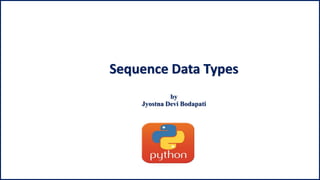



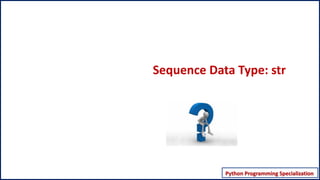

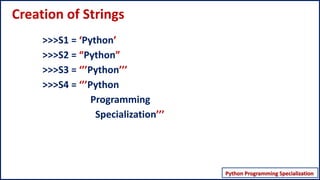
![Python Programming Specialization
Python Programming ¨C Data Structures
Accessing String Elements
? Let S1 = ¡°HELLO WORLD¡±
? How do we access the contents of the string?
? String elements can be accessed by passing an index with the name of the
string
? String name [ index ]](https://image.slidesharecdn.com/datatypessequence-201127090917/85/Python-Sequence-Data-types-in-Brief-8-320.jpg)

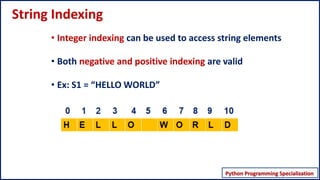

![Python Programming Specialization
Python Programming ¨C Data Structures
Accessing String Elements
? Ex: S1 = ¡°HELLO WORLD¡±
>>> S1 [ 0 ]
>>> S1 [ 4 ]
>>> S1 [ -2 ]
>>> S1 [ 2: 7 ]](https://image.slidesharecdn.com/datatypessequence-201127090917/85/Python-Sequence-Data-types-in-Brief-12-320.jpg)
![Python Programming Specialization
Python Programming ¨C Data Structures
Accessing String Elements
? Ex: S1 = ¡°HELLO WORLD¡±
>>> S1 [ 0 ]
>>> S1 [ 4 ]
>>> S1 [ -2 ]
>>> S1 [ 2 : 7 ]
>>> S1 [ 2 : 10 : 2 ]
#returns H
#returns O
#returns L
#returns LLO W
#returns LOWR](https://image.slidesharecdn.com/datatypessequence-201127090917/85/Python-Sequence-Data-types-in-Brief-13-320.jpg)
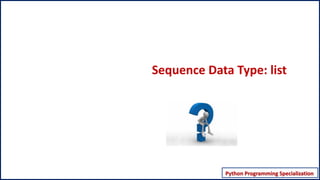
![Python Programming Specialization
Python Programming ¨C Data Structures
Sequence Types: list
? Ordered collections of objects? of same or different types
? Lists are Mutable?
? Examples:
? >>>L3 = [10, 20, 30, 40]
? >>> L4 = [¡®Ram', 786 , 2.23, ¡®Raj', 70.2]](https://image.slidesharecdn.com/datatypessequence-201127090917/85/Python-Sequence-Data-types-in-Brief-15-320.jpg)
![Python Programming Specialization
Python Programming ¨C Data Structures
Sequence Types: list
? L1 = [10, 20, 30, 40, 50, 60, 70]
? Access the entire list ¡ú use is its name.?
? >>> Print ( L1 )?
? Access a single item ¡ú use index operator [ ] ?
? >>> L1 [ 0 ] ?
? Access part of a list ¡ú use slicing operator [ : : ]?
? >>> L1 [ 4 : 8 : 2 ]](https://image.slidesharecdn.com/datatypessequence-201127090917/85/Python-Sequence-Data-types-in-Brief-16-320.jpg)
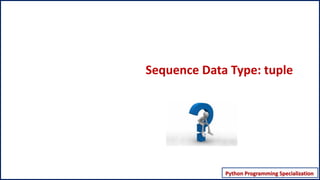

![Python Programming Specialization
Python Programming ¨C Data Structures
Access tuple Elements
? T1 = ( 10, 20, 30, 40, 50, 60, 70 )
? Access the entire tuple ¡ú use is its name.?
? >>> Print ( T1 )?
? Access a single item ¡ú use index operator [ ] ?
? >>> T1 [ 0 ] ?
? Access part of a tuple ¡ú use slicing operator [ : : ]?
? >>> T1 [ 2 : 6 : 2 ]](https://image.slidesharecdn.com/datatypessequence-201127090917/85/Python-Sequence-Data-types-in-Brief-19-320.jpg)
